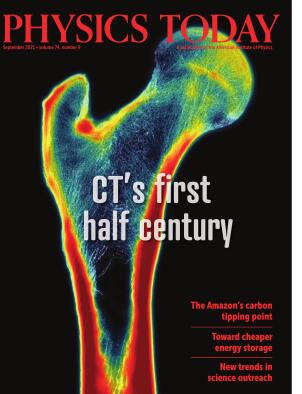Jack Steinberger
DOI: 10.1063/PT.3.4840
Jack Steinberger, a corecipient of the 1988 Nobel Prize in Physics, died on 12 December 2020 among his family at his home in Geneva.

Jack Steinberger
KONRAD KLEINKNECHT

Jack was born on 25 May 1921 to a Jewish family in Bad Kissingen, Germany. In 1934, the year after the Nazi Party came to power, US Jewish charities helping to relocate German refugee children found separate homes in Chicago for Jack and his older brother. Jack’s host eventually was able to bring his parents and younger brother to the US in 1938.
Jack studied chemical engineering at the Armour Institute of Technology (now the Illinois Institute of Technology) for two years and then used a scholarship to attend the University of Chicago, where he received an undergraduate degree in chemistry in 1942. He joined the US Army and worked at MIT in the antenna group. When he left the army not long after World War II ended, he went back to the University of Chicago. For his thesis, suggested by his adviser, Enrico Fermi, Jack conducted an experiment on cosmic-ray muons and found that they exhibit three-body decay, probably an electron and two neutrinos.
At the invitation of J. Robert Oppenheimer, Jack then went to the Institute for Advanced Study in Princeton, New Jersey. There he calculated the decay rate of a neutral pion to two gamma rays via intermediate nucleons. That calculation paved the way for later developments in theory—notably, the triangle anomaly.
In 1949 Jack went to the University of California, Berkeley, to work with theorist Gian Carlo Wick. Because of the many opportunities available, Jack began conducting experiments, including with Berkeley’s new electron synchrotron. With Wolfgang Panofsky and Jack Steller, he revealed the existence of neutral pions; with other colleagues, he measured the pion mean life.
After declining to sign an anti-communist loyalty oath, Jack left Berkeley the following year for Columbia University. Using the new 380 MeV cyclotron, Jack determined the spins and parities of charged and neutral pions and studied the scattering of charged pions. In 1954 Jack and three graduate students performed physics experiments with the bubble-chamber technique, developed two years earlier. Their first results uncovered the properties of unstable strange particles at a level unattainable with older techniques. A few months later, the four reported on three events that demonstrated the existence of the sigma-zero hyperon and measured its mass.
Over the next decade, Jack, working with numerous colleagues, made some groundbreaking discoveries. They included revealing parity violation in lambda hyperon decay and measuring the omega and rho meson decay lifetimes.
In 1961 Jack worked with Melvin Schwartz and Leon Lederman, among others, to conduct the first experiment to use a high-energy neutrino beam. The 10-ton detector had just enough mass to detect 51 neutrino-induced events and could discriminate between electrons and muons. They demonstrated that the accelerator neutrinos from pion decay produced muons but not electrons and that the neutrinos emitted in pion decay are distinct from those emitted in beta decay and therefore constitute a second kind of neutrinos. That work earned Steinberger, Schwartz, and Lederman the Nobel.
In 1964 Jack went to CERN on sabbatical. He proposed, with Carlo Rubbia, me, and others, to look for the interference between the long-lived
In 1968 Jack joined the staff at CERN, where he continued to study the
From 1976 to 1984, Jack led several groups—from CERN, the Technical University of Dortmund and Heidelberg University in Germany, and the Atomic Energy Commission in Saclay, France—in conducting an experiment on deep inelastic neutrino interactions in iron. The collaboration used CERN’s Super Proton Synchrotron to precisely determine the Weinberg angle of weak interactions, demonstrate the existence of right-handed neutral currents, and test quantum chromodynamics through scaling violations in the structure functions of the nucleon, among many other discoveries.
Beginning in 1983, Jack was also instrumental in designing and building the ALEPH detector for the Large Electron–Positron Collider, which started operations in 1989. Among the collider’s discoveries were the number of neutrino flavors and the decay modes of the intermediate neutral boson
In addition to his enormous achievements in physics, Jack played the flute, especially works of Johann Sebastian Bach, and held regular chamber-music sessions. Jack enjoyed mountaineering and skiing in the French Alps, and he regularly traveled from his home in Geneva to visit his native city of Bad Kissingen. He was made an honorary citizen, and the local secondary school was renamed after him.
To his students and collaborators, Jack had a great personality, characterized by his being a reliable friend and an exemplar of decency and imagination.
More about the Authors
Konrad Kleinknecht. Ludwig-Maximilians University Munich, Garching, Germany.
